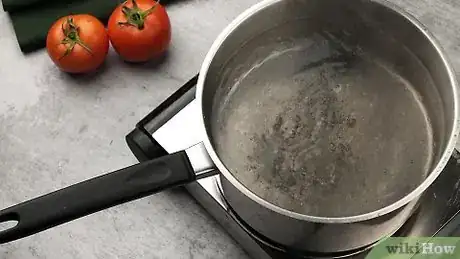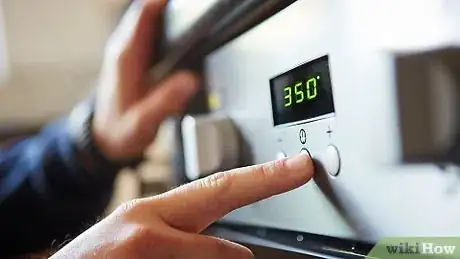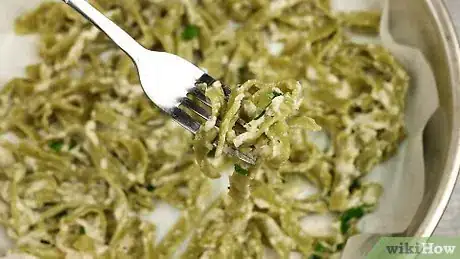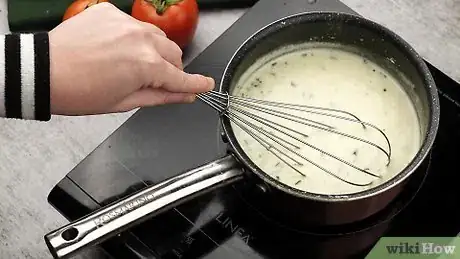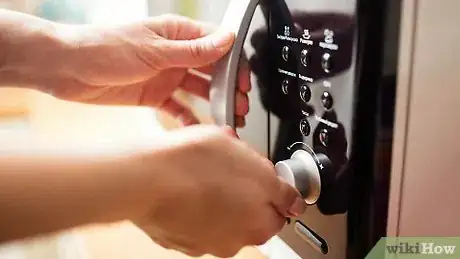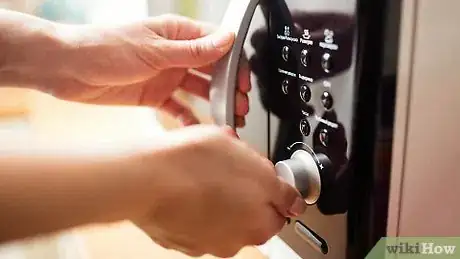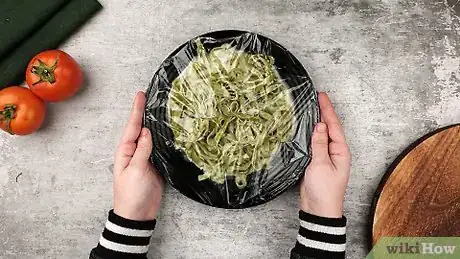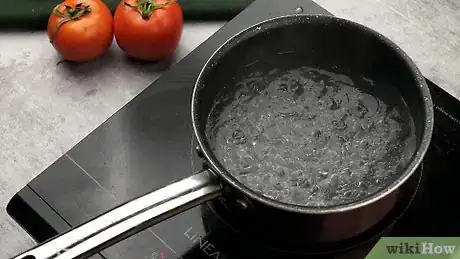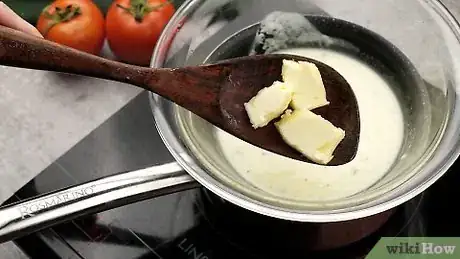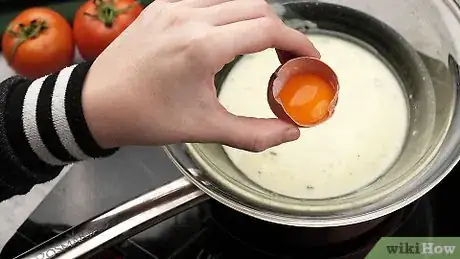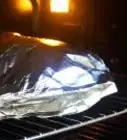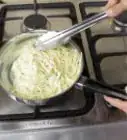This article was co-authored by wikiHow Staff. Our trained team of editors and researchers validate articles for accuracy and comprehensiveness. wikiHow's Content Management Team carefully monitors the work from our editorial staff to ensure that each article is backed by trusted research and meets our high quality standards.
The wikiHow Culinary Team also followed the article's instructions and verified that they work.
This article has been viewed 417,815 times.
Learn more...
Reheated pasta often ends up mushy, dried out, or sitting in a pool of oil. Luckily, these problems can be avoided with simple alterations to the heating process. Learn how to save your leftovers, whether they are plain noodles or an easily-separated cream sauce.
Steps
Reheating Plain Pasta
-
1Boil a pot of water. Pour in enough water to cover the noodles, but don't add them to the pot. Wait until the water comes to a boil.
- You may use the methods below instead, but this is the fastest and best option for pasta without sauce.
-
2Transfer the pasta to a metal strainer. Choose a metal strainer or colander that can fit into your pot. Ideally, find one with long handles for easy handling.Advertisement
-
3Dip the pasta into the boiling water. It only takes about thirty seconds to refresh most pasta. Withdraw the strainer and taste test the noodles. If they are not ready, return them to the water. Withdraw and taste test again every 15 seconds.[1]
- If your strainer does not have long handles, or if you do not have oven mitts, instead place the strainer in a bowl and pour boiling water over it.
Oven Method
-
1Preheat the oven. Set your oven to 350ºF (175ºC) and wait for it to preheat. This method is gentle on pasta and sauces, but may not be practical for a single serving.
-
2Add the pasta to a baking dish. Spread the pasta across a shallow dish. A deep pile of pasta may heat unevenly.
- If the pasta is dry, add a splash of milk or extra sauce to keep it moist. This is especially important for lasagna.[2]
-
3Cover with foil and bake. The pasta is usually ready in 20 minutes, but check after 15 just in case. The foil should help trap moisture, slowing the drying process.
- Optionally, add a sprinkle of Parmesan under the foil 5 minutes before the pasta is done.[3]
-
4Check the pasta. Stick a metal fork into the center of the pasta dish and wait for 10 to 15 seconds. If the tip of the fork is hot to the touch, the pasta is ready. If not, return the pasta to the oven.[4]
Stovetop Method
-
1Fry most pasta dishes over medium-low heat. This is one of the easiest ways to heat pasta. Just add melted butter or oil to a frying pan, add the pasta, and heat. Stir occasionally.
- Add more sauce if the pasta looks dry.
-
2Heat cream or wine sauces over low heat. These easily separated sauces should be heated over very low heat. For lower risk of separation, see the cream sauce method below.
-
3Fry lasagna. Cut yourself a slab and toss it on the pan, cut side down. Rotate occasionally, heating each cut side until crispy.[5]
Microwave Method
-
1Use the microwave for single servings only. Microwaves cook unevenly, especially if the pasta dishes contains cheese or vegetables. When reheating a large portion, use the oven instead for greater control.
- Avoid using the microwave for cream sauces, wine and butter sauces, or other sauces likely to separate.
-
2Toss the pasta with sauce or oil. If the pasta already includes sauce, just stir it to distribute it evenly. If the pasta is plain, stir in a little sauce or olive oil. This will help keep the pasta moist.
-
3Set the microwave to medium-low power. A full power microwave will likely turn your pasta to mush. Reduce it to 50% power or below.
-
4Cover the pasta. Place the pasta in a microwave-safe container, preferably a round one to avoid uneven heating at corners.[6] Cover it with one of the following two methods:
- Cover with plastic wrap, but leave one corner open for steam to escape.[7] This traps heat, warming the pasta more evenly.
- Cover with a damp paper towel. This steams the pasta as it heats up, adding moisture to dry or sauce-light noodles.
-
5Heat in short bursts. Heat the pasta for about 1 minute, then check on its progress and stir. If necessary, continue heating for 15–30 seconds at a time.
- If your microwave does not have a turntable, stop and rotate the dish halfway through.
Reheating Sauces
-
1Heat water in the base of a double boiler. This is by far the best method for cream-based sauces, such as Alfredo. The indirect heat ensures a more even, slower cooking method, reducing the chance of separation.
- You can make your own double boiler out of two pans, or one pan and a glass, heat-safe bowl.
- If a double boiler is not an option, use the stovetop method instead, over very low heat.
-
2Place the sauce in the top of the double boiler. If possible, heat the sauce separately, then pour over cold pasta or heat as described above. If the sauce and pasta are well mixed, just add them both to the container. Leave it here until the water begins to simmer.
- Reheating the pasta and sauce together shouldn't cause any major problems, but the risk of chewy or mushy noodles is a little higher.
-
3Add cream or milk to cream sauces. A cream sauce separates so easily because it is an "emulsion," or suspension of fat and water. A fresh splash of cream or whole milk helps keep these together, reducing the chance that the sauce becomes an oily mess.[8]
-
4Add butter or reduced cream to wine sauces. Wine sauces are also emulsions, but the acidity can cause cream to curdle. To avoid these, mix in a little melted butter instead. Another option is reduced cream, meaning cream heated in a separate pan until some of the liquid has evaporated.[9]
-
5Heat slowly, stirring occasionally. The lower the heat, the less likely your sauce is to separate. Stir gently, to avoid breaking apart the ingredients. Eat while the sauce is hot.
-
6Add an egg yolk in emergencies. If the sauce "breaks" apart while reheating, take it off the heat and transfer a couple spoonfuls to a bowl. Rapidly whisk an egg yolk into the bowl until smooth, then transfer the mixture back to the sauce.
- If you're heating the pasta as well as the sauce, the egg yolk method gets messy. Try a small handful of flour instead, to thicken the sauce and cut the greasiness.
- If you end up with lumps of cooked egg while whisking, discard that bowlful and try again with less liquid and faster whisking. If the lumps are small, just strain out the lumps and use the remaining liquid.
Community Q&A
-
QuestionHow many times can I reheat the leftovers before it stops working?
 Community AnswerHealth and safety guidelines will tell you once is probably enough. I've never encountered a problem with a second reheat myself, but I wouldn't recommend you do it more than twice.
Community AnswerHealth and safety guidelines will tell you once is probably enough. I've never encountered a problem with a second reheat myself, but I wouldn't recommend you do it more than twice.
Warnings
- Do not eat pasta cooked more than seven days ago, or pasta with an unusual smell.[12]⧼thumbs_response⧽
- Be careful, as all bowls and containers will be hot when you remove them from the microwave.⧼thumbs_response⧽
Things You'll Need
-
Plain pasta:
- metal colander or strainer
- oven mitts
- saucepan
- stove
-
Oven:
- baking dish
- foil
-
Stovetop:
- Frying pan
- Butter or oil
-
Cream or wine sauces:
- Double boiler
- Stirring utensil
- Cream or butter
- Egg yolk or flour (sometimes)
-
Microwave:
- Microwave safe container
- Plastic wrap or damp paper towel
References
- ↑ http://www.recipetips.com/kitchen-tips/t--535/reheating-pasta.asp
- ↑ http://www.recipetips.com/kitchen-tips/t--535/reheating-pasta.asp
- ↑ http://www.realsimple.com/food-recipes/cooking-tips-techniques/cooking/reheat-leftover-pasta
- ↑ http://www.recipetips.com/kitchen-tips/t--535/reheating-pasta.asp
- ↑ http://www.bonappetit.com/test-kitchen/cooking-tips/slideshow/how-to-reheat-leftovers/?slide=4
- ↑ http://www.recipetips.com/kitchen-tips/t--535/reheating-pasta.asp
- ↑ http://www.recipetips.com/kitchen-tips/t--535/reheating-pasta.asp
- ↑ http://www.bonappetit.com/test-kitchen/cooking-tips/slideshow/how-to-reheat-leftovers/?slide=4
- ↑ http://answers.google.com/answers/threadview/id/588429.html
About This Article
To reheat leftover pasta without it separating or drying up, start by transferring it to a baking dish and adding a splash of milk if it's dry. Then, cover the pan with foil and bake it in the oven for 20 minutes at 350 °F. To reheat leftover pasta in the microwave, put a single serving in a microwave-safe bowl and add a little bit of sauce or oil to help keep the pasta moist. Then, cover the bowl with plastic wrap or a damp paper towel and microwave it on medium-low heat for 1 minute. For other ways to reheat your leftover pasta, including how to reheat it if there's a sauce already on the pasta, read on!
